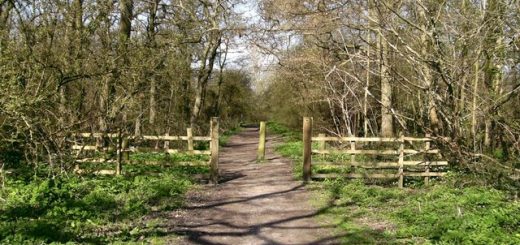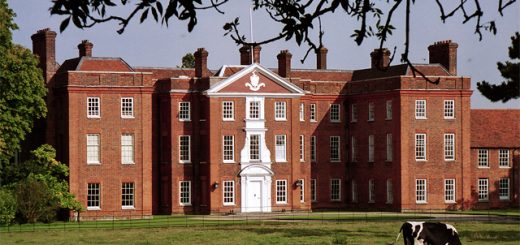Lady Mary Howard of Fitzford House
Fitzford House was the seat of the Fitz family from the 15th Century. It was demolished during the 1800’s, though the gatehouse, which is all that remains of the mansion was rebuilt in 1871. There is a story relating to Fitzford House involving a phantom carriage, a black dog and Lady Mary Howard (nee Fitz)
Mary (Christened 1 August 1596 – Died 1571) was the daughter of Sir John Fitz (Born 1575) of Fitzford House and his wife Bridget Courtenay, daughter of Sir William Courtenay, de jure 3rd Earl of Devon (Born 1553 – Died 24 June 1630). A violent drunk, John Fitz unlawfully killed Nicholas Slanning of Bickleigh, a friend of his in 1599, after which he fled to France. The influence of the 3rd Earl of Devon assisted in securing a pardon from the Queen enabling him to return.
Unfortunately his behaviour had not improved and he ejected his family from his house and started to terrorise Tavistock with a group of violent friends. In July 1605, King James I summoned Sir John to London to account for his actions. Enroute he stayed at the Anchor Inn which was run by Daniel Alley and his wife Agnes. Sir John Fitz killed the innkeeper and wounded his wife, probably in a fit of paranoia after he was awoken early. Realising his error when sanity was restored to him, Sir John stabbed himself twice and died after refusing medical assistance.
Mary Fitz inherited her father’s fortune aged nine years old. King James I made Mary a ward of Henry Percy, 9th Earl of Northumberland (Born 27 April 1564 – Died 5 November 1632) who married her to his brother Sir Allen Percy. Sir Allen however died of a fever whilst hunting in 1613.
Her second marriage was an elopement with Thomas Darcy who died shortly after the wedding.
Mary’s third husband was Sir Charles Howard, 4th son of the 1st Earl of Suffolk. Unfortunately he died in 1626.
In 1629 Sir Richard Grenville (1600–1658) became her fourth and last husband. They had a son and daughter together named Richard (Born 1630 – Hanged 1656 as a Highwayman) and Elizabeth (Born 1631). Sir Richard had a violent temper and was abusive to his wife. In 1631 they formally seperated and Richard was jailed. Mary took her son back to Fitzford House. She apparently gained a reputation of being hard hearted and eventually disinherited her children.
In ‘Songs of the West’ (1891), Baring-Gould published the following ballad and explained that ’Lady Howard was a person of strong will and imperious temper, and left a deep and lasting impression on the people of Tavistock. . . . She bore the reputation of having been hard-hearted in her lifetime. For some crime she had committed (nobody knew what), she was said to be doomed to run in the shape of a hound from the gateway of Fitzford to Okehampton Park, between the hours of midnight and cock-crowing, and to return with a single blade of grass in her mouth to the place whence she had started; and this she was to do till every blade was picked, when the world would be at an end.
“Dr. Jago, the clergyman of Milton Abbot, however, told me that occasionally she was said to ride in a coach of bones up West Street, Tavistock, towards the moor; and an old man of this place told a friend of mine the same story, adding that ‘he had seen her scores of times.’ A lady also who was once resident here, and whom I met in company, assured me that, happening many years before to pass the old gateway at Fitzford, as the church clock struck twelve, in returning from a party, she had herself seen the hound start.”
When a child I heard the story, but somewhat varied, that Lady Howard drove nightly from Okehampton Castle to Launceston Castle in a black coach driven by a headless coachman, and preceded by a fire-breathing black hound that when the coach stopped at a door, there was sure to be a death in that house the same night. There was a ballad about it, of which I can only recall fragments.”
My ladye hath a sable coach,
And horses two and four;
My ladye hath a black blood-hound
That runneth on before.
My ladye’s coach hath nodding plumes,
The driver hath no head;
My ladye is an ashen white,
As one that long is dead.
“Now pray step in!” my ladye saith,
“Now pray step in and ride.”
I thank thee, I had rather walk
Than gather to thy side.
The wheels go round without a sound,
Or tramp or turn of wheels;
As cloud at night, in pale moonlight,
Along the carriage steals.
“Now pray step in!” my ladye saith,
“Now prithee come to me.”
She takes the baby from the crib,
She sits it on her knee.
“Now pray step in!” my ladye saith,
“Now pray step in and ride.”
Then deadly pale, in waving veil,
She takes to her the bride.
“Now pray step in!” my ladye saith,
“There’s room I wot for you.”
She wav’d her hand, the coach did stand,
The Squire within she drew.
“Now pray step in!” my ladye saith,
“Why shouldst thou trudge afoot?”
She took the gaffer in by her,
His crutches in the boot.
I’d rather walk a hundred miles,
And run by night and day,
Than have that carriage halt for me
And hear my ladye say—
“Now pray step in, and make no din,
Step in with me to ride ;
There’s room, I trow, by me for you,
And all the world beside.”
The legend also appeared in a slightly early work, ‘English Fairy and Other Folk Tales’ by Edwin Sidney Hartland [1890]. ‘Lady Howard, a Devonshire notable of the time of James I., was remarkable for her beauty, her wealth, her talents, and accomplishments. But she had many bad qualities. Amongst others, she was unnaturally cruel to her only daughter, and had a sad knack of getting rid of her husbands, having been married no less than four times. At last she died herself, and, for her misdemeanours while living, her spirit was transformed into a hound, and compelled to run every night, between midnight and cock-crowing, from the gateway of Fitz-ford, her former residence, to Oakhampton Park, and bring back to the place from whence she started a single blade of grass in her mouth; and this penance she is doomed to continue till every blade of grass is removed from the park, which she will not be able to effect till the end of the world. How these particulars were communicated to our fellow-living mortals we are not informed, and we dare not venture a conjecture.’
Also;
Legend asserts that Lady Mary Howard of Fitzford is sentenced to spend eternity doing penance for her ‘evil deeds’. Her penance is to journey in a coach made from the bones of her husbands and driven by a headless driver, from Fitzford House to Okehampton Castle accompanied by a huge black dog with blood red eyes and savage fangs. On reaching the castle, the dog plucks a blade of grass and carries it back to Fitzford House, where it is laid upon a granite slab. Only once the grass has been completely removed at the castle will Lady Howard be released from her penance and allowed to rest in peace. [G H Radford 1890]






Re: Lady Mary Howard of Fitzford House
[BBC, FEBRUARY 2005] – The Tale Of The Wronged Lady
BBC Devon’s Andrew Spencer investigates one of the oldest ghost stories in Devon which, he says, is also one of the least accurate in a historical sense.
Not that it stops Devon’s dark lady riding her coach each night in search of repentance….
"My ladye hath a sable coach,
And horses two and four;
My ladye hath a black blood-hound
That runneth on before.
My ladye’s coach hath nodding plumes,
The driver hath no head;
My ladye is an ashen white,
As one that long is dead."
As the gates of Fitzford House creak open a fearsome sight appears, a massive black dog with glowing red eyes bounds out leading a morbid sight.
A large horse-drawn carriage made of bones follows, driven by a headless coachman and a ghostly white lady sits inside as it makes its way the 16 miles to Okehampton Castle.
When it reaches the castle the dog, with ceremony, goes to the castle mound and plucks one blade of grass.
The spectral procession then turns and rides back to Fitzford House where the blade of grass is laid on a stone and the spectres vanish back to where they came from.
This is the nightly torment of Lady Mary Howard, and when the castle mound is finally free of any grass she’ll be allowed to finally rest easy.
This punishment is very traditional in the same way as Sisyphus pushing his rock up a hill, a long, tedious and repetitive task with the added factor of possible "release" at the end, but only after a distinctly impossible mission is completed.
The possible injustice of this fate however is that Lady Howard herself was actually the wronged party and the legends about her are widely suggested to revolve more about her father than her.
John Fitz, her father, became very rich, very young at the age of 21. Like many before and after him the money soon turned him into a moral-less shadow of his former self, sliding into a degeneracy that caused him to vent his wrath on the folk of Tavistock and led to the murder of two men, including his own best friend, killed on the doorstep of Fitzford House.
Mary found herself hated almost by proxy as stories about her father’s behaviour became twisted around to land on her own shoulders.
John Fitz commited suicide, aged 30, after sliding into insanity and Mary, just nine at the time, was sold by King James I to the Earl of Northumberland who forcibly married her at 12 to his brother Sir Alan Percy, simply to gain her fortune as the last of her line.
This was the first of four husbands, all of whom she outlived. Percy died after catching a cold on a hunting expedition and that left her free to choose the man she desired, Thomas Darcy. Her one marriage for love however ended in tragedy as Darcy died just months after the two eloped and wed.
The final two of her marriages were both about money, and both failed because Mary was a much more assertive lady than the scared nine year old thrust around when orphaned. Mary refused to let her husbands milk her dry and soon tied up her fortunes to keep them safe. This led to massive arguments and the break up of both marriages and the death of both husbands.
Mary then retired back to a ruined Fitz house that had been left deserted with her one remaining family member, a beloved son from her last marriage called George.
She hoped to live out her days in relative peace but life had one more shock for her, the premature death of George. This was the last break her heart could take and she died exactly one month after her son.
After her death, her life began to become a local legend and as such became skewed from the truth. Her own life became merged with that of her father and the deaths of her husbands became less and less innocent until it reached the height of maliciousness; the tale she had murdered all four husbands.
Finally the legend was born, Lady Howard, in the coach made of her husbands bones, riding on her futile journey each night, never allowed the rest in death from the adversity that was her life.